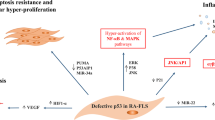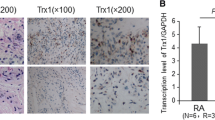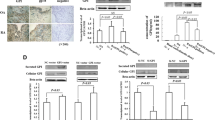Abstract
We undertook this study to determine whether the altered expression of telomeric proteins TPP1 and POT1 in fibroblast-like synovial cells (FLS) could provide insights into the pathogenesis of rheumatoid arthritis (RA). FLS were isolated from patients with RA, osteoarthritis (OA) and traumatic joint disease, and cultured in vitro. TPP1 and POT1 mRNA level of FLS were measured using real-time quantitative polymerase chain reaction (RT-qPCR) in 42 RA, 23 OA and 13 healthy cases. Immunofluorescence staining and Western blot were used to detect the expression of TPP1 and POT1 protein. Expression of TPP1 and POT1 mRNA was significantly reduced in RA cases (P < 0.001, respectively), and no significant difference was observed between OA and healthy cases (P > 0.05, respectively). Confocal microscopy images showed TPP1 and POT1 proteins mainly located in nucleus of FLS. Western blot demonstrated that TPP1 protein level was significantly reduced in RA cases (P < 0.001), and POT1 protein expression was not statistical significance among RA, OA patients and healthy cases (P > 0.05). Significant negative correlation was observed between level of TPP1 mRNA and titers of anti-CCP antibody (P < 0.001), RF (P < 0.01). Altered expression of TPP1 might contribute to persistent proliferation of FLS in RA, further study on functions of telomeric proteins in RA would be needed.


Similar content being viewed by others
References
Huber LC, Distler O, Tarner I et al (2006) Synovial fibroblasts: key players in rheumatoid arthritis. Rheumatology (Oxford) 45:669–675
Shore D (2001) Telomeric chromatin: replicating and wrapping up chromosome ends. Curr Opin Genet Dev 11:189–198
Cohen SB, Graham ME, Lovrecz GO et al (2007) Protein composition of catalytically active human telomerase from immortal cells. Science 315:1850–1853
de Lange T (2005) Shelterin: the protein complex that shapes and safeguards human telomeres. Genes Dev 19:2100–2110
Gilson E, Geli V (2007) How telomeres are replicated. Nat Rev Mol Cell Biol 8:825–838
Wang F, Podell ER, Zaug AJ et al (2007) The POT1-TPP1 telomere complex is a telomerase processivity factor. Nature 445:506–510
Xin H, Liu D, Wan M et al (2007) TPP1 is a homologue of ciliate TEBP-beta and interacts with POT1 to recruit telomerase. Nature 445:559–562
Houghtaling BR, Cuttonaro L, Chang W et al (2004) A dynamic molecular link between the telomere length regulator TRF1 and the chromosome end protector TRF2. Curr Biol 14:1621–1631
Kim S, Beausejour C, Davalos AR et al (2004) TIN2 mediates functions of TRF2 at human telomeres. J Biol Chem 279:43799–43804
Liu D, Safari A, O’Connor MS et al (2004) PTOP interacts with POT1 and regulates its localization to telomeres. Nat Cell Biol 6:673–680
Liu D, O’Connor MS, Qin J et al (2004) Telosome, a mammalian telomere-associated complex formed by multiple telomeric proteins. J Biol Chem 279:51338–51342
Ye JZ, Hockemeyer D, Krutchinsky AN et al (2004) POT1-interacting protein PIP1: a telomere length regulator that recruits POT1 to the TIN2/TRF1 complex. Genes Dev 18:1649–1654
Ye JZ, Donigian JR, van Overbeek M et al (2004) TIN2 binds TRF1 and TRF2 simultaneously and stabilizes the TRF2 complex on telomeres. J Biol Chem 279:47264–47271
Yang Q, Zheng YL, Harris CC (2005) POT1 and TRF2 cooperate to maintain telomeric integrity. Mol Cell Biol 25:1070–1080
O’Connor MS, Safari A, Xin H et al (2006) A critical role for TPP1 and TIN2 interaction in high-order telomeric complex assembly. Proc Natl Acad Sci USA 103:11874–11879
Verdun RE, Crabbe L, Haggblom C et al (2005) Functional human telomeres are recognized as DNA damage in G2 of the cell cycle. Mol Cell 20:551–561
Verdun RE, Karlseder J (2007) Replication and protection of telomeres. Nature 447:924–931
Yamanishi Y, Hiyama K, Maeda H et al (1998) Telomerase activity in rheumatoid synovium correlates with the mononuclear cell infiltration level and disease aggressiveness of rheumatoid arthritis. J Rheumatol 25:214–220
Yudoh K, Matsuno H, Nezuka T et al (1999) Different mechanisms of synovial hyperplasia in rheumatoid arthritis and pigmented villonodular synovitis: the role of telomerase activity in synovial proliferation. Arthritis Rheum 42:669–677
Tsumuki H, Hasunuma T, Kobata T et al (2000) Basic FGF-induced activation of telomerase in rheumatoid synoviocytes. Rheumatol Int 19:123–128
Steer SE, Williams FM, Kato B et al (2007) Reduced telomere length in rheumatoid arthritis is independent of disease activity and duration. Ann Rheum Dis 66:476–480
Tarhan F, Vural F, Kosova B et al (2008) Telomerase activity in connective tissue diseases: elevated in rheumatoid arthritis, but markedly decreased in systemic sclerosis. Rheumatol Int 28:579–583
Kondo T, Oue N, Yoshida K et al (2004) Expression of POT1 is associated with tumor stage and telomere length in gastric carcinoma. Cancer Res 64:523–529
Muller-Ladner U, Kriegsmann J, Franklin BN et al (1996) Synovial fibroblasts of patients with rheumatoid arthritis attach to and invade normal human cartilage when engrafted into SCID mice. Am J Pathol 149:1607–1615
Stanczyk J, Ospelt C, Gay RE et al (2006) Synovial cell activation. Curr Opin Rheumatol 18:262–267
Arnett FC, Edworthy SM, Bloch DA et al (1998) The American Rheumatism Association 1987 revised criteria for the classification of rheumatoid arthritis. Arthritis Rheum 31:315–324
Altman R, Asch E, Bloch D et al (1986) Development of criteria for the classification and reporting of osteoarthritis. Classification of osteoarthritis of the knee. Diagnostic and therapeutic criteria committee of the American Rheumatism Association. Arthritis Rheum 29:1039–1049
Scanu A, Oliviero F, Braghetto L et al (2007) Synoviocyte cultures from synovial fluid. Reumatism 59:66–70
Yamanishi Y, Boyle DL, Green DR et al (2005) P53 tumor suppressor gene mutations in fibroblast-like synoviocytes from erosion synovium and non-erosion synovium in rheumatoid arthritis. Arthritis Res Ther 7:R12–R18
Cawthon RM (2002) Telomere measurement by quantitative PCR. Nucleic Acids Res 30:e47
Gil ME, Coetzer TL (2004) Real-time quantitative PCR of telomere length. Mol Biotechnol 27:169–172
Schmittgen TD, Livak KJ (2008) Analyzing real-time PCR data by the comparative C (T) method. Nat Protoc 3:1101–1108
Stebulis JA, Rossetti RG, Atez FJ et al (2005) Fibroblast-like synovial cells derived from synovial fluid. J Rheumatol 32:301–306
Zvaifler NJ (1995) Rheumatoid arthritis. The multiple pathways to chronic synovitis. Lab Invest 73:307–310
Panayi GS (1997) T-cell-dependent pathways in rheumatoid arthritis. Curr Opin Rheumatol 9:236–240
Fox DA (1997) The role of T cells in the immunopathogenesis of rheumatoid arthritis: new perspectives. Arthritis Rheum 40:598–609
KoopmanWJ GayS (1993) Do nonimmunologically mediated pathways play a role in the pathogenesis of rheumatoid arthritis? Rheum Dis Clin North Am 19:107–122
Imamura F, Aono H, Hasunuma T et al (1998) Monoclonal expansion of synoviocytes in rheumatoid arthritis. Arthritis Rheum 41:1979–1986
Aupperle KR, Boyle DL, Hendrix M et al (1998) Regulation of synoviocyte proliferation, apoptosis, and invasion by the p53 tumor suppressor gene. Am J Pathol 52:1091–1098
Reme T, Travaglio A, Gueydon E et al (1998) Mutation of the p53 tumour suppressor gene in erosive rheumatoid synovial tissue. Clin Exp Immunol 111:353–358
Dooley S, Herlitzka I, Hanselmann R et al (1996) Constitutive expression of c-fos and c-jun, overexpression of ets-2, and reduced expression of metastasis suppressor gene nm23-H1 in rheumatoid arthritis. Ann Rheum Dis 55:298–304
Kontny E, Ziolkowska M, Dudzinka E et al (1995) Modified expression of c-Fos and c-Jun proteins and production of interleukin-1 beta in patients with rheumatoid arthritis. Clin Exp Rheumatol 13:51–57
Pap T, Nawrath M, Heinrich J et al (2004) Cooperation of Ras and c-Myc-dependent pathways in regulating the growth and invasiveness of synovial fibroblasts in rheumatoid arthritis. Arthritis Rheum 50:2794–2802
Kim NW, Piatyszek MA, Prowse KR et al (1994) Specific association of human telomerase activity with immortal cells and cancer. Science 266:2011–2015
Kelleher C, Kurth I, Lingner J (2005) Human protection of telomeres 1 (POT1) is a negative regulator of telomerase activity in vitro. Mol Cell Biol 25:808–818
Bunch JT, Bae NS, Leonardi J et al (2005) Distinct requirements for Pot1 in limiting telomere length and maintaining chromosome stability. Mol Cell Biol 25:5567–5678
Miyoshi T, Kanoh J, Saito M et al (2008) Fission yeast Pot1-Tpp1 protects telomeres and regulates telomere length. Science 320:1341–1344
Guo X, Deng Y, Lin Y et al (2007) Dysfunctional telomeres activate an ATM-ATR-dependent DNA damage response to suppress tumorigenesis. EMBO J 26:4709–4719
Nishimura K, Sugiyama D, Kogata Y et al (2007) Meta-analysis: diagnostic accuracy of anti-cyclic citrullinated peptide antibody and rheumatoid factor for rheumatoid arthritis. Ann Intern Med 146:797–808
Chen LY, Liu D, Songyang Z (2007) Telomere maintenance through spatial control of telomeric proteins. Mol Cell Biol 27:5898–5909
Mackay JMK, Panayi G, Neill WA et al (1974) Cytology of rheumatoid synovial cells in culture. I. Composition and sequence of cell populations in cultures of rheumatoid synovial fluid. Ann Rheum Dis 33:225–233
Panayi GS, Mackay JM, Neill WA et al (1974) Cytology of rheumatoid synovial cells in culture. II. Association of polykaryocytes with rheumatoid and other forms of arthritis. Ann Rheum Dis 33:234–239
Neidhart M, Seemayer CA, Hummel KM et al (2003) Functional characterization of adherent synovial fluid cells in rheumatoid arthritis: destructive potential in vitro and in vivo. Arthritis Rheum 48:1873–1880
Acknowledgments
This work was supported by the Department of Health of Sichuan, PR China (grant number: 080099).
Conflict of interest
All the authors declare that they have no conflicts of interest.
Author information
Authors and Affiliations
Corresponding author
Rights and permissions
About this article
Cite this article
Qing, YF., Zhou, JG., Zhao, MC. et al. Altered expression of TPP1 in fibroblast-like synovial cells might be involved in the pathogenesis of rheumatoid arthritis. Rheumatol Int 32, 2503–2510 (2012). https://doi.org/10.1007/s00296-011-1992-x
Received:
Accepted:
Published:
Issue Date:
DOI: https://doi.org/10.1007/s00296-011-1992-x




